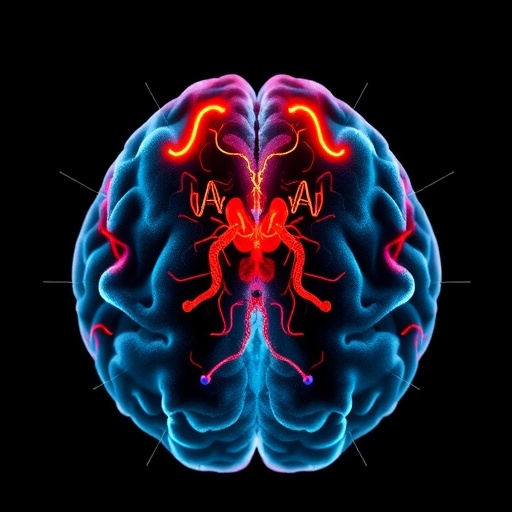
In a groundbreaking study published in Cell Research this year, a team of neuroscientists has unveiled a complex molecular interplay involving autism-related proteins that is crucial for maintaining striatal asymmetry in the mouse brain. This discovery provides not only profound insights into the intricate architecture of neural circuits but also opens a new frontier for understanding the biological substrates underlying neurodevelopmental disorders such as autism spectrum disorder (ASD). By elucidating how these proteins interact to establish and preserve the lateralized organization of the striatum, one of the brain’s fundamental hubs for motor control and cognitive function, the research could pave the way for novel therapeutic approaches targeting circuit-specific pathologies.
The striatum, a subcortical structure deeply embedded within the basal ganglia, orchestrates a variety of essential brain functions, including voluntary movement, reward processing, and decision-making. Critically, the striatum exhibits functional and molecular asymmetry between its left and right hemispheres, a feature associated with behavioral and cognitive lateralization in mammals. Disruptions in this asymmetry have been implicated in several neurological and psychiatric conditions, highlighting the importance of deciphering the molecular mechanisms responsible for its establishment and maintenance. Until now, however, the precise molecular framework sustaining this structural and functional lateralization remained elusive.
The research team led by Jiang, Zhu, and Zhong approached this mystery by focusing on a consortium of proteins previously linked with autism, known collectively to modulate synaptic development and neural connectivity. Prior studies have well documented that mutations or dysregulations of these proteins cause profound synaptic and circuit behavioral anomalies typical of ASD. What remained unclear was how these proteins might interplay to influence the lateralized architecture of key brain regions such as the striatum. Employing a multidisciplinary methodology that integrates advanced genetic engineering, proteomics, and high-resolution imaging, the researchers uncovered a previously uncharacterized protein complex that is required to preserve the asymmetrical scaffold of the striatum.
At the heart of this discovery is the identification of a multiprotein complex composed primarily of three autism-related proteins that coalesce to form a stable molecular unit within medium spiny neurons—the principal neuronal type in the striatum. These proteins, long studied individually for their roles in autism pathology, now emerge as cooperative agents maintaining molecular gradients and synaptic specificity across the left and right striatal hemispheres. Disruption of any one member of this complex resulted in aberrant synaptic morphology and a breakdown of the intrinsic asymmetry, leading to marked alterations in striatal-dependent behaviors in mouse models.
The methodological rigor employed in the study merits attention, as the authors combined CRISPR/Cas9 gene-editing techniques to selectively knock out individual proteins with proteomic analyses that mapped the interaction landscape and post-translational modifications within this complex. Such precise molecular dissection allowed for the visualization of how the absence of one component reorganized the proteomic milieu, triggering a cascade of synaptic and circuit-level reconfigurations. By coupling these findings with live imaging of neuronal activity patterns, the team demonstrated a direct functional consequence on the neural networks governing striatal lateralization.
One of the most striking revelations from this research is the dynamic nature of striatal asymmetry as a regulated feature governed by protein complex stability rather than a fixed developmental endpoint. This positions the autism-related protein complex as a critical molecular hub mediating plasticity within the striatal circuitry. The findings challenge the conventional view of brain asymmetry as a static anatomical trait, instead painting it as an actively maintained process vulnerable to molecular perturbations associated with neurodevelopmental diseases.
Implications of these findings extend beyond basic neuroscience, offering new therapeutic targets for correcting circuit dysfunctions linked to ASD. The identified protein complex functions as a molecular linchpin, and modulating its stability or interaction dynamics could, in theory, restore striatal symmetry and normalize associated behavioral phenotypes. Given the difficulty in treating core symptoms of autism, strategies aimed at stabilizing or mimicking the function of this complex represent a promising direction for intervention studies.
Moreover, this study enriches the broader understanding of how lateralization—a defining feature of mammalian brains related to cognitive specialization—may be encoded and preserved at the molecular level. Lateralization facilitates multitasking and more efficient processing by segregating neural functions, and this research suggests that disruptions in protein networks underpinning this segregation may contribute to cognitive impairments in ASD and other neurological conditions. The delineation of these molecular pathways offers an explanatory framework for previously observed hemispheric functional imbalances reported in patients.
The experimental design also incorporated behavioral assays that corroborated the molecular and circuit-level observations. Mice lacking any component of the identified protein complex exhibited deficits in motor learning, social interaction, and sensory processing—behaviors typically reliant on intact striatal circuits and known to be compromised in autism models. These phenotypic manifestations affirm the biological relevance of striatal asymmetry maintenance and underscore how molecular disruptions ripple outward to influence whole-animal behavioral outcomes.
In addition to advancing knowledge of brain asymmetry, the study pioneers a new conceptual approach to investigating protein complexes in neurodevelopmental disorders. The focus on multimeric protein assemblies rather than individual proteins mirrors the complexity of biological systems and encourages future research to adopt network-oriented perspectives when studying gene/protein dysfunction. This paradigm shift is likely to accelerate the identification of coordinated molecular interventions in disorders characterized by polygenic and molecular heterogeneity.
Technically, the study’s comprehensive use of super-resolution microscopy allowed for visualizing subcellular localization patterns of the protein complex, revealing a striking asymmetrical distribution at dendritic spines within the striatum. This spatial specificity is crucial, as it suggests that molecular asymmetry is not merely a global brain characteristic but is precisely mediated at the synaptic level, thereby influencing circuit dynamics at a microcircuit scale. The interplay between synaptic architecture and functional asymmetry is an area ripe for further exploration.
Highlighting translational potential, the authors propose that human orthologs of the identified proteins should be examined in clinical populations to assess correlation with striatal lateralization markers and autism phenotypes. Advanced neuroimaging techniques such as functional MRI and diffusion tensor imaging might be employed to detect subtle hemispheric imbalances that mirror those observed in the mouse models. Such cross-species analyses could validate the relevance of this protein complex in human brain lateralization and ASD pathology.
This discovery also invites a reevaluation of developmental timelines during which striatal asymmetry is most susceptible to manipulation. If the protein complex’s function is critical during specific neurodevelopmental windows, it could inform the timing of therapeutic interventions to maximize efficacy. Early diagnosis and targeted treatments during these sensitive periods could potentially correct or mitigate aberrant circuit formation before behavioral impairments solidify.
The paper further speculates on whether similar protein complexes govern asymmetry in other lateralized brain regions, such as the cerebral cortex and hippocampus. If so, this molecular mechanism might represent a universally employed strategy to establish functional lateralization across diverse neural systems. Future comparative studies are needed to explore the conservation and divergence of such complexes, expanding the impact of this work beyond basal ganglia circuits.
Ultimately, Jiang et al.’s research represents a tour de force in neurobiology, integrating molecular, cellular, circuit, and behavioral data to unravel a previously underappreciated dimension of brain organization. The revelation that autism-related proteins coalesce into a functional complex to maintain striatal asymmetry illuminates new pathways by which genetic influences shape brain lateralization, with broad ramifications for understanding typical and atypical neurodevelopment.
As this field moves forward, the challenge will be to translate these molecular insights into clinical benefits. Developing small molecules or biologics that stabilize the protein complex or compensate for its dysfunction could lead to transformative treatments for autism and related disorders. Until then, this research stands as a testament to the power of integrative neuroscience in revealing the hidden molecular choreography that sculpts the brain’s asymmetric beauty.
Subject of Research: Autism-related proteins and striatal asymmetry maintenance in mice
Article Title: Autism-related proteins form a complex to maintain the striatal asymmetry in mice
Article References:
Jiang, Y., Zhu, F., Zhong, J. et al. Autism-related proteins form a complex to maintain the striatal asymmetry in mice. Cell Res (2025). https://doi.org/10.1038/s41422-025-01174-9
Image Credits: AI Generated
Tags: autism-related proteinsbasal ganglia functioncognitive lateralization in mammalsdecision-making processes in striatummechanisms of lateralized organizationmolecular interplay in neurosciencemotor control in the brainneural circuit architectureneurodevelopmental disorders researchstriatal asymmetry in micestructural and functional asymmetrytherapeutic approaches for autism




